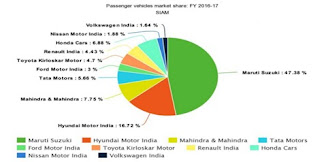On 18th of May when GM India announced
that it is exiting from Indian domestic market by the end of 2017, the very
first thought popped up in my mind as a reaction was “how on the earth Mary
Barra (The CEO of GM) & her team can come up with such a strategy which
shuns you from the one of the biggest & emerging markets called India and
then speak about restructuring of global operations for growth.” My fundamental question is can you explain me
how by giving up in one of the most competitively ‘growing’ market, the company
plans to achieve higher growth? I intend to analyze (from two perspectives) the
decision of GM India to shut down its’ car selling business to Indian customers
in domestic market and focus only on production for export from India.
Part 1. What could be
possible drivers behind the decision of exiting from Indian domestic market?
Part 2. Analyzing the decision under current
conditions whether it looks justified or not?
In this blog I’ll be dealing with part 1. Some of the
possible drivers could be identified as under;
1. Consistent
churning at the top: Constant churning at the top management never augurs
well for the health of the organization and same goes with the case of GM India.
Frequent changes at the top position indicate high level of uncertainty about
the organization. As per this
article, GM India has seen nine CEO in the span of 21 years in India. This
gives average tenure of CEO around 2.5 years. Every new CEO who joins, has
generally tendency to realign organization’s goals and strategies this act if
done too frequently(happened in case of GM India) can keep organizations and
its’ stakeholders in fragile mode. GM India never had chance to see the stable
policies in terms of goals & strategies which can reap the benefits.
2. Extremely poor market share: GM India
has sold around
25,823 cars in 2016-17 resulting into less than 1% market share in India.
Market share break up as per SIAM is as below;
GM India is nowhere in the above chart which makes a strong
case for shutting down the hugely unsuccessful venture in Indian market. Extremely
small market share brings range of problems for any company but there is
brighter side to this which will be discussed in part-2.
3. Inheritance of financial
troubles of parent company & investors’ pressure: The Company (GM- USA)
which was on verge of bankruptcy during 2008 crisis and bailed out by
Government of USA by purchasing
61% equity stake worth of $50 Bil. has never come out truly from financial troubles since then. Eventually
government sold the stake from GM-USA with decent loss. When parent company
does not have strong financial muscle, one can imagine how competitive the
negotiations can be in the meeting rooms with Parent company when various country heads
demanding higher budgetary allocation for their subsidiary. Indian subsidiary
which has generated very low RoI (Returns on Investment) despite being present
in such emerging market for more than two decades. This must have put future of
GM India on radar of parent company. Lesser financial resource allocation to
under-performing subsidiaries is logical decision, this financial crunch has
also contributed towards decision of exiting Indian domestic market. Investors’
pressure has also generated enough heat as
stock performance of GM has remained subdue. Two years back CEO Mary Barra
has said that India is strategic market and will invest further & now GM
India is exiting from Indian market this shows how much of investor pressure
for better financial performance can lead to harsh and unwanted decisions.
4. Failure to
understand Indian market & cut throat competition: Many experts have
noted and highlighted the failure
of certain automobile MNCs including GM India due to not being able to
adopt the Indian culture and inability
to understand unique requirement of Indian customers. In India many factors
such as price, fuel efficiency, cost of ownership etc. play an important role unlike
some of the developed markets. Interesting to observe that in such a huge Indian market
Maruti Suzuki has near 50% market share while all other big MNC names such as
Toyota, GM, Ford, Volkswagen etc. have managed very small fraction of the
market share. One of the reasons is lack of small car portfolio (Most of the
MNCs never had much of small cars in their portfolio as in other developed
markets big cars are demanded more) which is most successful auto segment in Indian
consumer market. Lack of consistent product and brand strategy has also played
its’ role in denting the position of GM India. It started with Opel brands with
Astra & Corsa, then around 2003 it introduced Chevrolet brand and later it
has moved to Chinese models. Frequent launches and withdrawals of cars have led
to shallow brand loyalty and very challenging new customer acquisition.

No comments:
Post a Comment